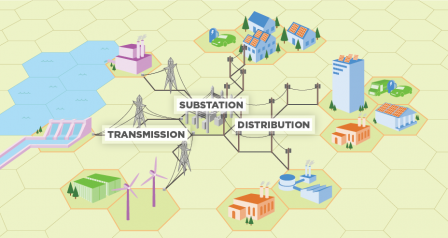Modernizing Electricity Delivery
 View an interactive version of this diagram >>
View an interactive version of this diagram >>
- About modernizing electricity delivery
- Modernizing electricity delivery in the United States
- Environmental impacts of modernizing electricity delivery
About Modernizing Electricity Delivery
Modernizing electricity delivery can help grid operators better understand and respond to how power is flowing across transmission and distribution lines. These new capabilities are enabled by incorporating information and communications technologies across a variety of new and existing controls, sensors, and software systems. Modern grid, or smart grid, investments can enable grid operators to respond faster to changes in grid conditions and allow for two-way communication between utilities and electricity end-users. The U.S. Department of Energy maintains additional background on its What is the Smart Grid? website.
Modernizing Electricity Delivery in the United States
Electricity delivery systems have traditionally been built with a goal of providing economic, reliable electricity service and expanding to meet new or growing demand for electricity consumption. While meeting these goals, modern electricity delivery systems can also be planned and managed to provide additional benefits, such as accommodating growth in renewable resources and increasing energy efficiency.
A growing number of utilities and grid operators have gained experience with modern grid deployments due in part to the American Recovery and Reinvestment Act of 2009. Overseen by the U.S. Department of Energy, Smart Grid Investment Grants were awarded to nearly 100 recipients to accelerate the modernization of the nation’s electricity infrastructure.
Environmental Impacts of Modernizing Electricity Delivery
How the electricity delivery system is designed, operated, and managed is critical to achieving economic, reliability, and environmental benefits with a modern grid. Modern electricity delivery technologies may increase the energy efficiency of the overall electricity system by reducing energy losses along transmission and distribution lines and delivering higher quality electricity to industry, businesses, and homes. Electricity usage data from smart meters may be used to support other energy efficiency efforts and reduce consumption.
Modernizing electricity delivery may also enable greater integration of renewable energy resources through changes to how grid operators manage and deploy resources such as storage or demand response during periods when renewable resources wane (e.g., when solar production decreases due to cloud cover). Integrating renewable energy resources can provide environmental benefits by avoiding the adverse environmental effects from other electricity generation options.
The environmental benefits of modernizing electricity delivery are expected to outweigh the negative effects. Possible environmental concerns include:
- Increased electricity use at data centers. Digital information used by modern grid technologies may be stored in data centers, which use energy to run computers and to provide cooling. As data centers grow to handle increased amounts of information from many sectors of the economy, increased energy demands can be mitigated by using more energy-efficient network equipment and building systems.
- Manufacturing and electricity use of modern grid technologies. Manufacturing and use of advanced meters and other modern grid devices requires energy and resources. Grid-connected products must be kept on or at least in standby mode to allow them to send and receive communications, which also consumes power, although opportunities exist to reduce standby power use through proper design.
- Waste. Old equipment must be recycled or otherwise managed as waste when it is replaced. Meters, thermostats, and other devices may contain mercury or other hazardous materials. (Learn more about mercury disposal.) In some cases, though, replacing equipment can help the environment. For example, many high-voltage circuit breakers and switches are insulated with sulfur hexafluoride, which is a potent greenhouse gas. Some newer devices require less sulfur hexafluoride than older devices and may be less likely to leak this gas into the air. Learn more about sulfur hexafluoride in electric power systems.
Electromagnetic radiation. Advanced (“smart”) meters transmit data using radio-frequency waves, which are a form of electromagnetic radiation. However, the radiation given off by a smart meter is similar in type and strength to the radiation from other common consumer devices. For more information on health effects of exposure to different types of radiation, see EPA’s radiation protection page.
